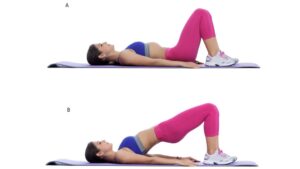Glute bridges are a highly effective exercise that targets the gluteal muscles, particularly the gluteus maximus, and also engages the core and lower back muscles. This exercise helps strengthen and tone the buttocks while providing other benefits to your overall fitness.

How to Perform Glute Bridges
- Starting Position: Lie on your back with your knees bent and feet flat on the floor, hip-width apart. Place your arms at your sides with your palms facing down.
- Engage Core: Ensure your spine is in a neutral position, and engage your core muscles by gently pulling your belly button toward your spine.
- Lift Hips: Push through your heels to lift your hips off the ground while squeezing your glutes at the top of the movement. Keep your feet, shoulders, and upper back on the ground.
- Hip Extension: Lift your hips as high as you can while maintaining a straight line from your shoulders to your knees at the top of the movement. Imagine forming a diagonal line from your knees to your shoulders.
- Pause and Squeeze: Hold the bridge position for a moment, focusing on squeezing your glutes.
- Lower Hips: Lower your hips back down to the starting position without resting them on the ground. Maintain control throughout the movement.
- Repeat: Perform the desired number of repetitions.
Tips for Effective Glute Bridges
- Focus on proper form and alignment throughout the exercise to avoid straining your lower back.
- Engage your glutes at the top of the movement and hold the contraction for a second or two for maximum muscle engagement.
- Avoid arching your back or overextending your lower back during the lift.
- Keep your knees in line with your feet, and don’t let them collapse inward.
- You can vary the intensity of the exercise by performing single-leg glute bridges or using a resistance band placed just above your knees for added resistance.
Benefits of Glute Bridges
- Glute Strengthening: Glute bridges primarily target the gluteus maximus, helping to strengthen and tone these large muscles responsible for hip extension and thigh rotation.
- Improved Hip Mobility: Regularly performing glute bridges can help improve hip mobility and flexibility, which can be beneficial for various physical activities.
- Core Activation: Glute bridges engage the core muscles, helping to improve core stability and support the lower back.
- Reduced Lower Back Pain: Strengthening the glutes and core can alleviate lower back pain by providing better support to the lumbar spine.
- Posture Improvement: Strong glutes play a role in maintaining good posture and reducing the risk of postural issues.
- Athletic Performance: Strong glutes contribute to better athletic performance in activities such as running, jumping, and lifting.
- Injury Prevention: A strong posterior chain (including the glutes) can reduce the risk of knee and lower back injuries.
Variations of Glute Bridges:
- Single-Leg Glute Bridge: Perform the exercise with one leg extended straight in the air, while the other leg remains bent.
- Elevated Glute Bridge: Place your feet on an elevated surface, such as a bench or step, to increase the range of motion and challenge your glutes further.
- Weighted Glute Bridge: Hold a dumbbell, barbell, or weighted plate on your hips to add resistance to the exercise.
Finally, incorporating glute bridges into your regular workout routine can help you achieve stronger and more toned glutes while benefiting your overall fitness and posture. Remember to perform the exercise with proper form and gradually increase intensity as needed.










